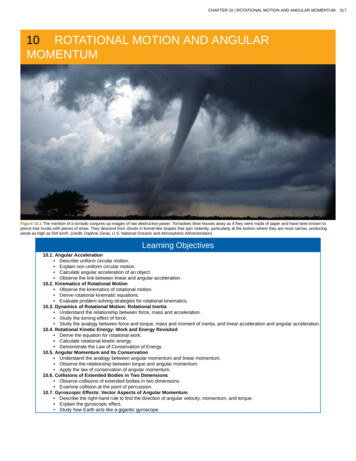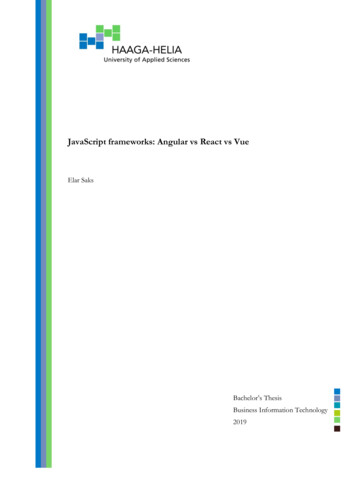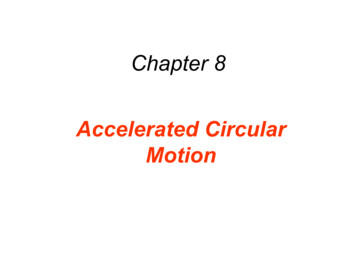
Transcription
CHAPTER 10 ROTATIONAL MOTION AND ANGULAR MOMENTUM10 ROTATIONAL MOTION AND ANGULARMOMENTUMFigure 10.1 The mention of a tornado conjures up images of raw destructive power. Tornadoes blow houses away as if they were made of paper and have been known topierce tree trunks with pieces of straw. They descend from clouds in funnel-like shapes that spin violently, particularly at the bottom where they are most narrow, producingwinds as high as 500 km/h. (credit: Daphne Zaras, U.S. National Oceanic and Atmospheric Administration)Learning Objectives10.1. Angular Acceleration Describe uniform circular motion. Explain non-uniform circular motion. Calculate angular acceleration of an object. Observe the link between linear and angular acceleration.10.2. Kinematics of Rotational Motion Observe the kinematics of rotational motion. Derive rotational kinematic equations. Evaluate problem solving strategies for rotational kinematics.10.3. Dynamics of Rotational Motion: Rotational Inertia Understand the relationship between force, mass and acceleration. Study the turning effect of force. Study the analogy between force and torque, mass and moment of inertia, and linear acceleration and angular acceleration.10.4. Rotational Kinetic Energy: Work and Energy Revisited Derive the equation for rotational work. Calculate rotational kinetic energy. Demonstrate the Law of Conservation of Energy.10.5. Angular Momentum and Its Conservation Understand the analogy between angular momentum and linear momentum. Observe the relationship between torque and angular momentum. Apply the law of conservation of angular momentum.10.6. Collisions of Extended Bodies in Two Dimensions Observe collisions of extended bodies in two dimensions. Examine collision at the point of percussion.10.7. Gyroscopic Effects: Vector Aspects of Angular Momentum Describe the right-hand rule to find the direction of angular velocity, momentum, and torque. Explain the gyroscopic effect. Study how Earth acts like a gigantic gyroscope.317
318CHAPTER 10 ROTATIONAL MOTION AND ANGULAR MOMENTUMIntroduction to Rotational Motion and Angular MomentumWhy do tornadoes spin at all? And why do tornados spin so rapidly? The answer is that air masses that produce tornadoes are themselves rotating,and when the radii of the air masses decrease, their rate of rotation increases. An ice skater increases her spin in an exactly analogous manner asseen in Figure 10.2. The skater starts her rotation with outstretched limbs and increases her spin by pulling them in toward her body. The samephysics describes the exhilarating spin of a skater and the wrenching force of a tornado.Clearly, force, energy, and power are associated with rotational motion. These and other aspects of rotational motion are covered in this chapter. Weshall see that all important aspects of rotational motion either have already been defined for linear motion or have exact analogs in linear motion.First, we look at angular acceleration—the rotational analog of linear acceleration.Figure 10.2 This figure skater increases her rate of spin by pulling her arms and her extended leg closer to her axis of rotation. (credit: Luu, Wikimedia Commons)10.1 Angular AccelerationUniform Circular Motion and Gravitation discussed only uniform circular motion, which is motion in a circle at constant speed and, hence, constantangular velocity. Recall that angular velocity ω was defined as the time rate of change of angle θ :ω Δθ ,Δtwhere θ is the angle of rotation as seen in Figure 10.3. The relationship between angular velocityRotation Angle and Angular Velocity as(10.1)ω and linear velocity v was also defined inv rω(10.2)ω vr ,(10.3)orwhere r is the radius of curvature, also seen in Figure 10.3. According to the sign convention, the counter clockwise direction is considered aspositive direction and clockwise direction as negativeFigure 10.3 This figure shows uniform circular motion and some of its defined quantities.Angular velocity is not constant when a skater pulls in her arms, when a child starts up a merry-go-round from rest, or when a computer’s hard diskslows to a halt when switched off. In all these cases, there is an angular acceleration, in which ω changes. The faster the change occurs, thegreater the angular acceleration. Angular acceleration α is defined as the rate of change of angular velocity. In equation form, angular acceleration isexpressed as follows:α Δω ,ΔtThis content is available for free at http://cnx.org/content/col11406/1.7(10.4)
CHAPTER 10 ROTATIONAL MOTION AND ANGULAR MOMENTUMΔω is the change in angular velocity and Δt is the change in time. The units of angular acceleration are (rad/s)/s , or rad/s 2 . If ωincreases, then α is positive. If ω decreases, then α is negative.whereExample 10.1 Calculating the Angular Acceleration and Deceleration of a Bike WheelSuppose a teenager puts her bicycle on its back and starts the rear wheel spinning from rest to a final angular velocity of 250 rpm in 5.00 s. (a)Calculate the angular acceleration in rad/s 2 . (b) If she now slams on the brakes, causing an angular acceleration of – 87.3 rad/s 2 , how longdoes it take the wheel to stop?Strategy for (a)The angular acceleration can be found directly from its definition inΔω is 250 rpm and Δt is 5.00 s.α Δω because the final angular velocity and time are given. We see thatΔtSolution for (a)Entering known information into the definition of angular acceleration, we getα ΔωΔt250 rpm .5.00 sBecause Δω is in revolutions per minute (rpm) and we want the standard units offrom rpm to rad/s:(10.5)rad/s 2 for angular acceleration, we need to convert Δωrad 1 minΔω 250 rev 2πrevmin60 secrad 26.2 s .Entering this quantity into the expression for(10.6)α , we getα ΔωΔt26.2rad/s 5.00 s 5.24 rad/s 2.(10.7)Strategy for (b)In this part, we know the angular acceleration and the initial angular velocity. We can find the stoppage time by using the definition of angularacceleration and solving for Δt , yieldingΔt Δωα .(10.8)Solution for (b)Here the angular velocity decreases fromThus,26.2 rad/s (250 rpm) to zero, so that Δω is – 26.2 rad/s , and α is given to be – 87.3 rad/s 2 .– 26.2 rad/s– 87.3 rad/s 2 0.300 s.Δt (10.9)DiscussionNote that the angular acceleration as the girl spins the wheel is small and positive; it takes 5 s to produce an appreciable angular velocity. Whenshe hits the brake, the angular acceleration is large and negative. The angular velocity quickly goes to zero. In both cases, the relationships areanalogous to what happens with linear motion. For example, there is a large deceleration when you crash into a brick wall—the velocity changeis large in a short time interval.If the bicycle in the preceding example had been on its wheels instead of upside-down, it would first have accelerated along the ground and thencome to a stop. This connection between circular motion and linear motion needs to be explored. For example, it would be useful to know how linearand angular acceleration are related. In circular motion, linear acceleration is tangent to the circle at the point of interest, as seen in Figure 10.4.Thus, linear acceleration is called tangential acceleration a t .319
320CHAPTER 10 ROTATIONAL MOTION AND ANGULAR MOMENTUMFigure 10.4 In circular motion, linear accelerationacceleration is also called tangential accelerationa , occurs as the magnitude of the velocity changes: aat .is tangent to the motion. In the context of circular motion, linearLinear or tangential acceleration refers to changes in the magnitude of velocity but not its direction. We know from Uniform Circular Motion andGravitation that in circular motion centripetal acceleration, a c , refers to changes in the direction of the velocity but not its magnitude. An objecta t and a c are perpendicular and independent ofa t is directly related to the angular acceleration α and is linked to an increase or decrease in the velocity, butundergoing circular motion experiences centripetal acceleration, as seen in Figure 10.5. Thus,one another. Tangential accelerationnot its direction.Figure 10.5 Centripetal accelerationacoccurs as the direction of velocity changes; it is perpendicular to the circular motion. Centripetal and tangential acceleration are thusperpendicular to each other.Now we can find the exact relationship between linear accelerationa t and angular acceleration α . Because linear acceleration is proportional to achange in the magnitude of the velocity, it is defined (as it was in One-Dimensional Kinematics) to bea t Δv .ΔtFor circular motion, note thatv rω , so thatat The radius(10.10)Δ(rω).Δt(10.11)r is constant for circular motion, and so Δ(rω) r(Δω) . Thus,By definition,a t r Δω .Δt(10.12)a t rα,(10.13)aα rt .(10.14)α Δω . Thus,ΔtorThese equations mean that linear acceleration and angular acceleration are directly proportional. The greater the angular acceleration is, the largerthe linear (tangential) acceleration is, and vice versa. For example, the greater the angular acceleration of a car’s drive wheels, the greater theacceleration of the car. The radius also matters. For example, the smaller a wheel, the smaller its linear acceleration for a given angular accelerationα.This content is available for free at http://cnx.org/content/col11406/1.7
CHAPTER 10 ROTATIONAL MOTION AND ANGULAR MOMENTUMExample 10.2 Calculating the Angular Acceleration of a Motorcycle WheelA powerful motorcycle can accelerate from 0 to 30.0 m/s (about 108 km/h) in 4.20 s. What is the angular acceleration of its 0.320-m-radiuswheels? (See Figure 10.6.)Figure 10.6 The linear acceleration of a motorcycle is accompanied by an angular acceleration of its wheels.StrategyWe are given information about the linear velocities of the motorcycle. Thus, we can find its linear accelerationaα rt can be used to find the angular acceleration.a t . Then, the expressionSolutionThe linear acceleration isa t ΔvΔt30.0m/s 4.20 s 7.14 m/s 2.(10.15)aa t and r into α rt , we getaα rt2 7.14 m/s0.320 m 22.3 rad/s 2.We also know the radius of the wheels. Entering the values for(10.16)DiscussionUnits of radians are dimensionless and appear in any relationship between angular and linear quantities.So far, we have defined three rotational quantities—θ, ω , and α . These quantities are analogous to the translational quantities x, v , and a .Table 10.1 displays rotational quantities, the analogous translational quantities, and the relationships between them.Table 10.1 Rotational and tionshipθxθ xrωvω vrαaaα rtMaking Connections: Take-Home ExperimentSit down with your feet on the ground on a chair that rotates. Lift one of your legs such that it is unbent (straightened out). Using the other leg,begin to rotate yourself by pushing on the ground. Stop using your leg to push the ground but allow the chair to rotate. From the origin where youbegan, sketch the angle, angular velocity, and angular acceleration of your leg as a function of time in the form of three separate graphs.Estimate the magnitudes of these quantities.Check Your UnderstandingAngular acceleration is a vector, having both magnitude and direction. How do we denote its magnitude and direction? Illustrate with an example.Solution321
322CHAPTER 10 ROTATIONAL MOTION AND ANGULAR MOMENTUMThe magnitude of angular acceleration is α and its most common units are rad/s 2 . The direction of angular acceleration along a fixed axis isdenoted by a or a – sign, just as the direction of linear acceleration in one dimension is denoted by a or a – sign. For example, consider agymnast doing a forward flip. Her angular momentum would be parallel to the mat and to her left. The magnitude of her angular accelerationwould be proportional to her angular velocity (spin rate) and her moment of inertia about her spin axis.PhET Explorations: Ladybug RevolutionJoin the ladybug in an exploration of rotational motion. Rotate the merry-go-round to change its angle, or choose a constant angular velocity orangular acceleration. Explore how circular motion relates to the bug's x,y position, velocity, and acceleration using vectors or graphs.Figure 10.7 Ladybug Revolution (http://cnx.org/content/m42177/1.4/rotation en.jar)10.2 Kinematics of Rotational MotionJust by using our intuition, we can begin to see how rotational quantities like θ , ω , and α are related to one another. For example, if a motorcyclewheel has a large angular acceleration for a fairly long time, it ends up spinning rapidly and rotates through many revolutions. In more technicalterms, if the wheel’s angular acceleration α is large for a long period of time t , then the final angular velocity ω and angle of rotation θ are large.The wheel’s rotational motion is exactly analogous to the fact that the motorcycle’s large translational acceleration produces a large final velocity, andthe distance traveled will also be large.Kinematics is the description of motion. The kinematics of rotational motion describes the relationships among rotation angle, angular velocity,angular acceleration, and time. Let us start by finding an equation relating ω , α , and t . To determine this equation, we recall a familiar kinematicequation for translational, or straight-line, motion:v v 0 at(constant a)(10.17)a a t , and we shall use the symbol a for tangential or linear acceleration from now on. As in linear kinematics, weassume a is constant, which means that angular acceleration α is also a constant, because a rα . Now, let us substitute v rω and a rαNote that in rotational motioninto the linear equation above:rω rω 0 rαt.The radius(10.18)r cancels in the equation, yieldingω ω 0 at(constant a),(10.19)ω 0 is the initial angular velocity. This last equation is a kinematic relationship among ω , α , and t —that is, it describes their relationshipwithout reference to forces or masses that may affect rotation. It is also precisely analogous in form to its translational counterpart.whereMaking ConnectionsKinematics for rotational motion is completely analogous to translational kinematics, first presented in One-Dimensional Kinematics.Kinematics is concerned with the description of motion without regard to force or mass. We will find that translational kinematic quantities, suchas displacement, velocity, and acceleration have direct analogs in rotational motion.Starting with the four kinematic equations we developed in One-Dimensional Kinematics, we can derive the following four rotational kinematicequations (presented together with their translational counterparts):Table 10.2 Rotational Kinematic EquationsRotationalTranslationalθ ω̄tx v- tω ω 0 αtv v 0 atθ ω 0t 1 αt 22x v 0t 1 at 2 (constant α , a )2(constantα, a)ω 2 ω 0 2 2αθ v 2 v 0 2 2ax (constant α , a )This content is available for free at http://cnx.org/content/col11406/1.7
CHAPTER 10 ROTATIONAL MOTION AND ANGULAR MOMENTUMIn these equations, the subscript 0 denotes initial values ( θ 0 ,velocityv- are defined as follows:ω̄ - and averagex 0 , and t 0 are initial values), and the average angular velocity ωω0 ωv vand v̄ 0.22The equations given above in Table 10.2 can be used to solve any rotational or translational kinematics problem in which(10.20)a and α are constant.Problem-Solving Strategy for Rotational Kinematics1. Examine the situation to determine that rotational kinematics (rotational motion) is involved. Rotation must be involved, but without the needto consider forces or masses that affect the motion.2. Identify exactly what needs to be determined in the problem (identify the unknowns). A sketch of the situation is useful.3. Make a list of what is given or can be inferred from the problem as stated (identify the knowns).4. Solve the appropriate equation or equations for the quantity to be determined (the unknown). It can be useful to think in terms of atranslational analog because by now you are familiar with such motion.5. Substitute the known values along with their units into the appropriate equation, and obtain numerical solutions complete with units. Besure to use units of radians for angles.6. Check your answer to see if it is reasonable: Does your answer make sense?Example 10.3 Calculating the Acceleration of a Fishing ReelA deep-sea fisherman hooks a big fish that swims away from the boat pulling the fishing line from his fishing reel. The whole system is initially atrest and the fishing line unwinds from the reel at a radius of 4.50 cm from its axis of rotation. The reel is given an angular acceleration of110 rad/s 2 for 2.00 s as seen in Figure 10.8.(a) What is the final angular velocity of the reel?(b) At what speed is fishing line leaving the reel after 2.00 s elapses?(c) How many revolutions does the reel make?(d) How many meters of fishing line come off the reel in this time?StrategyIn each part of this example, the strategy is the same as it was for solving problems in linear kinematics. In particular, known values are identifiedand a relationship is then sought that can be used to solve for the unknown.Solution for (a)Hereα and t are given and ω needs to be determined. The most straightforward equation to use is ω ω 0 αt because the unknown isalready on one side and all other terms are known. That equation states thatWe are also given thatω ω 0 αt.(10.21)ω 0 110 rad/s 2 (2.00s) 220 rad/s.(10.22)ω 0 0 (it starts from rest), so thatSolution for (b)Now thatω is known, the speed v can most easily be found using the relationshipwhere the radiusv rω,(10.23)v (0.0450 m)(220 rad/s) 9.90 m/s.(10.24)r of the reel is given to be 4.50 cm; thus,Note again that radians must always be used in any calculation relating linear and angular quantities. Also, because radians are dimensionless,we have m rad m .Solution for (c)1 rev 2π rad , we can find the number of revolutions by finding θ in radians.We are given α and t , and we know ω 0 is zero, so that θ can be obtained using θ ω 0t 1 αt 2 .2Here, we are asked to find the number of revolutions. Becauseθ ω 0t 1 αt 22 0 (0.500) 110 rad/s 2 (2.00 s) 2 220 rad.(10.25)θ (220 rad) 1 rev 35.0 rev.2π rad(10.26)Converting radians to revolutions gives323
324CHAPTER 10 ROTATIONAL MOTION AND ANGULAR MOMENTUMSolution for (d)The number of meters of fishing line isx , which can be obtained through its relationship with θ :x rθ (0.0450 m)(220 rad) 9.90 m.(10.27)DiscussionThis example illustrates that relationships among rotational quantities are highly analogous to those among linear quantities. We also see in thisexample how linear and rotational quantities are connected. The answers to the questions are realistic. After unwinding for two seconds, the reelis found to spin at 220 rad/s, which is 2100 rpm. (No wonder reels sometimes make high-pitched sounds.) The amount of fishing line played outis 9.90 m, about right for when the big fish bites.Figure 10.8 Fishing line coming off a rotating reel moves linearly. Example 10.3 and Example 10.4 consider relationships between rotational and linear quantities associatedwith a fishing reel.Example 10.4 Calculating the Duration When the Fishing Reel Slows Down and StopsNow let us consider what happens if the fisherman applies a brake to the spinning reel, achieving an angular acceleration ofHow long does it take the reel to come to a stop?– 300 rad/s 2 .StrategyWe are asked to find the timet for the reel to come to a stop. The initial and final conditions are different from those in the previous problem,ω 0 220 rad/s and the final angular velocity ω is zero.which involved the same fishing reel. Now we see that the initial angular velocity isThe angular acceleration is given to be α 300 rad/s 2 . Examining the available equations, we see all quantities but t are known inω ω 0 αt, making it easiest to use this equation.SolutionThe equation statesω ω 0 αt.(10.28)We solve the equation algebraically for t, and then substitute the known values as usual, yieldingt ω ω 0 0 220 rad/s 0.733 s.α 300 rad/s 2(10.29)DiscussionNote that care must be taken with the signs that indicate the directions of various quantities. Also, note that the time to stop the reel is fairly smallbecause the acceleration is rather large. Fishing lines sometimes snap because of the accelerations involved, and fishermen often let the fishswim for a while before applying brakes on the reel. A tired fish will be slower, requiring a smaller acceleration.Example 10.5 Calculating the Slow Acceleration of Trains and Their WheelsLarge freight trains accelerate very slowly. Suppose one such train accelerates from rest, giving its 0.350-m-radius wheels an angularacceleration of 0.250 rad/s 2 . After the wheels have made 200 revolutions (assume no slippage): (a) How far has the train moved down thetrack? (b) What are the final angular velocity of the wheels and the linear velocity of the train?StrategyIn part (a), we are asked to find x , and in (b) we are asked to findwheels r , and the angular acceleration α .ω and v . We are given the number of revolutions θ , the radius of theSolution for (a)The distancex is very easily found from the relationship between distance and rotation angle:This content is available for free at http://cnx.org/content/col11406/1.7
CHAPTER 10 ROTATIONAL MOTION AND ANGULAR MOMENTUMSolving this equation forθ xr .(10.30)x rθ.(10.31)x yieldsBefore using this equation, we must convert the number of revolutions into radians, because we are dealing with a relationship between linearand rotational quantities:θ (200 rev) 2π rad 1257 rad.1 revNow we can substitute the known values into(10.32)x rθ to find the distance the train moved down the track:x rθ (0.350 m)(1257 rad) 440 m.(10.33)Solution for (b)We cannot use any equation that incorporates t to find ω , because the equation would have at least two unknown values. The equationω 2 ω 0 2 2αθ will work, because we know the values for all variables except ω :ω 2 ω 0 2 2αθ(10.34)Taking the square root of this equation and entering the known values givesω 0 2(0.250 rad/s 2)(1257 rad) 1/2(10.35) 25.1 rad/s.We can find the linear velocity of the train,v , through its relationship to ω :v rω (0.350 m)(25.1 rad/s) 8.77 m/s.(10.36)DiscussionThe distance traveled is fairly large and the final velocity is fairly slow (just under 32 km/h).There is translational motion even for something spinning in place, as the following example illustrates. Figure 10.9 shows a fly on the edge of arotating microwave oven plate. The example below calculates the total distance it travels.Figure 10.9 The image shows a microwave plate. The fly makes revolutions while the food is heated (along with the fly).Example 10.6 Calculating the Distance Traveled by a Fly on the Edge of a Microwave Oven PlateA person decides to use a microwave oven to reheat some lunch. In the process, a fly accidentally flies into the microwave and lands on theouter edge of the rotating plate and remains there. If the plate has a radius of 0.15 m and rotates at 6.0 rpm, calculate the total distance traveledby the fly during a 2.0-min cooking period. (Ignore the start-up and slow-down times.)StrategyFirst, find the total number of revolutions6.0 rpm.- is given to beθ , and then the linear distance x traveled. θ ω̄ t can be used to find θ because ωSolutionEntering known values intoθ ω̄ t gives- t 6.0 rpm (2.0 min) 12 rev.θ ω (10.37)325
326CHAPTER 10 ROTATIONAL MOTION AND ANGULAR MOMENTUMAs always, it is necessary to convert revolutions to radians before calculating a linear quantity like x from an angular quantity like θ :θ (12 rev) 2π rad 75.4 rad.1 revNow, using the relationship between(10.38)x and θ , we can determine the distance traveled:x rθ (0.15 m)(75.4 rad) 11 m.(10.39)DiscussionQuite a trip (if it survives)! Note that this distance is the total distance traveled by the fly. Displacement is actually zero for complete revolutionsbecause they bring the fly back to its original position. The distinction between total distance traveled and displacement was first noted in OneDimensional Kinematics.Check Your UnderstandingRotational kinematics has many useful relationships, often expressed in equation form. Are these relationships laws of physics or are they simplydescriptive? (Hint: the same question applies to linear kinematics.)SolutionRotational kinematics (just like linear kinematics) is descriptive and does not represent laws of nature. With kinematics, we can describe manythings to great precision but kinematics does not consider causes. For example, a large angular acceleration describes a very rapid change inangular velocity without any consideration of its cause.10.3 Dynamics of Rotational Motion: Rotational InertiaIf you have ever spun a bike wheel or pushed a merry-go-round, you know that force is needed to change angular velocity as seen in Figure 10.10.In fact, your intuition is reliable in predicting many of the factors that are involved. For example, we know that a door opens slowly if we push tooclose to its hinges. Furthermore, we know that the more massive the door, the more slowly it opens. The first example implies that the farther theforce is applied from the pivot, the greater the angular acceleration; another implication is that angular acceleration is inversely proportional to mass.These relationships should seem very similar to the familiar relationships among force, mass, and acceleration embodied in Newton’s second law ofmotion. There are, in fact, precise rotational analogs to both force and mass.Figure 10.10 Force is required to spin the bike wheel. The greater the force, the greater the angular acceleration produced. The more massive the wheel, the smaller theangular acceleration. If you push on a spoke closer to the axle, the angular acceleration will be smaller.F on a pointF ismass m that is at a distance r from a pivot point, as shown in Figure 10.11. Because the force is perpendicular to r , an acceleration a mobtained in the direction of F . We can rearrange this equation such that F ma and then look for ways to relate this expression to expressions forrotational quantities. We note that a rα , and we substitute this expression into F ma , yieldingTo develop the precise relationship among force, mass, radius, and angular acceleration, consider what happens if we exert a forceF mrα.Recall that torque is the turning effectiveness of a force. In this case, because F is perpendicular toboth sides of the equation above by r , we get torque on the left-hand side. That is,(10.40)r , torque is simply τ Fr . So, if we multiplyrF mr 2α(10.41)τ mr 2α.(10.42)orThis last equation is the rotational analog of Newton’s second law ( F ma ), where torque is analogous to force, angular acceleration is analogousto translational acceleration, and mr 2 is analogous to mass (or inertia). The quantity mr 2 is called the rotational inertia or moment of inertia of apoint massm a distance r from the center of rotation.This content is available for free at http://cnx.org/content/col11406/1.7
CHAPTER 10 ROTATIONAL MOTION AND ANGULAR MOMENTUMFigure 10.11 An object is supported by a horizontal frictionless table and is attached to a pivot point by a cord that supplies centripetal force. A forceperpendicular to the radius r , causing it to accelerate about the pivot point. The force is kept perpendicular to r .Fis applied to the objectMaking Connections: Rotational Motion DynamicsDynamics for rotational motion is completely analogous to linear or translational dynamics. Dynamics is concerned with force and mass and theireffects on motion. For rotational motion, we will find direct analogs to force and mass that behave just as we would expect from our earlierexperiences.Rotational Inertia and Moment of InertiaBefore we can consider the rotation of anything other than a point mass like the one in Figure 10.11, we must extend the idea of rotational inertia toall types of objects. To expand our concept of rotational inertia, we define the moment of inertia I of an object to be the sum of mr 2 for all thepoint masses of which it is composed. That is,I mr 2 . Here I is analogous to m in translational motion. Because of the distance r , themoment of inertia for any object depends on the chosen axis. Actually, calculatingI is beyond the scope of this text except for one simple case—thatof a hoop, which has all its mass at the same distance from its axis. A hoop’s moment of inertia around its axis is thereforeMR 2 , where M is itsR its radius. (We use M and R for an entire object to distinguish them from m and r for point masses.) In all other cases, wemust consult Figure 10.12 (note that the table is piece of artwork that has shapes as well as formulae) for formulas for I that have been derivedtotal mass andfrom integration over the continuous body. Note thatI has units of mass multiplied by distance squared ( kg m 2 ), as we might expect from itsdefinition.The general relationship among torque, moment of inertia, and angular acceleration isnet τ Iα(10.43)α net τ ,I(10.44)orτ is the total torque from all forces relative to a chosen axis. For simplicity, we will only consider torques exerted by forces in the plane ofthe rotation. Such torques are either positive or negative and add like ordinary numbers. The relationship in τ Iα, α net τ is the rotationalIwhere netanalog to Newton’s second law and is very generally applicable. This equation is actually valid for any torque, applied to any object, relative to anyaxis.As we might expect, the larger the torque is, the larger the angular acceleration is. For example, the harder a child pushes on a merry-go-round, thefaster it accelerates. Furthermore, the more massive a merry-go-round, the slower i
angular velocity. Recall that angular velocityωwas defined as the time rate of change of angleθ: Δt, whereθis the angle of rotation as seen inFigure 10.3. The relationship between angular velocityωand linear velocityvwas also defined in Rotation Angle and Angular Velocityas v rω (10.2) or ω vr, (10.3)










